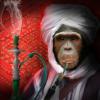Hookah History
I came across this while surfing. Name of the source is unfortunately missing. And there are parts of I don't agree with, but posted here for your pleasure.
The origin of Hookah smoking can be dated millennia back and its initial traces have been found in the North Western provinces of India alongside the border of Pakistan in the state of Rajasthan and Gujarat. The Hookahs of the ancient times were very simple, rSPAM!!!ed and archaic in design. The initial Hookahs were crafted out of a coconut shell base. The Hookah headed for Persian Kingdom and made its way towards Pakistan, Afghanistan, many parts of Asia and Arab parts of Northern Africa. To know more about the origin & history of Hookah smoking, read on…
While on the way to Persia, Hukkah smokers came across a new concept of Tombeik, which refers to a dark tobacco that is predominantly cultivated in modern day Iran. Tombeik is washed and packed in the large heads designed in the old style. Hot coal is then aMFlied to the wet Tombeik and this lends a strong flavor to the tobacco. These primitive style heads of Hookah were more popularly known as "ghelune" amongst the Persians. The Hookahs designed at the time of Persian Empire are still crafted with hand using pieces of wood.
By the nineteenth century, many women in Persia indulged in Hukkah smoking considering it to be a great pastime activity. When Hookah found its way in Turkey, it gained momentum at a very fast pace. It became an icon of fashion and a symbol of high status. It transformed completely in terms of its style and design. It became quite complex in designing and attained its final shape that we find today. New additions were made like the introduction of brass and glass in the designing of Hukkah water pipe. To enhance the aesthetic aMFeal, mosaics and elaborate paintings were added.
Hookah saw tremendous popularity in its growth in the Turk society. It went to the extent of finding its way in the bars. The Hookah bar tender was given the same status as that of a chef, due to the extensive preparations required in setting the Hookah. The tradition of smoking Hukkah went a step ahead and headed towards Lebanon and Syria, where it was named Nargile. Later, it migrated to Egypt and Morocco, where it got the name Shisha. In Saudi Arabia and the United Arab Emirates., it is popularly known as Hubble bubble. In the contemporary times, Hookah bars are seen as a social place, where people discuss on varied issues such as politics and several local events.<br style="clear: both;">
Hookah, commonly referred to as "Shisha" or "Nargila" in Arab countries, first originated in India. A common misconception about hookah is that it was invented by Arabs and was distributed to other regions. However, the Indians conceived this single or multi-stemmed Water pipe and through the British colonization of India, it was distributed throughout Western countries. Hookah has, since long ago, been a recreational pastime for many in Middle Eastern Countries. Its popularity has recently caught on in many Western countries, with the opening of Hookah Lounges and the distribution of Hookah parts gaining steam anywhere from the UK to the USA.
The first Hookahs were unlike those of modern-day smoking aficionados. Extremely primitive in design, function was the only aspect taken into consideration. Hookahs were often Coconut shells attached to a wooden pipe, and were primarily used to smoke opium or NHT (Non-Hookah Tobacco). As popularity for this newfound activity grew, hookah fever spread throughout the entire Persian Kingdom, anywhere from modern-day North Africa, all the way to the Middle-East and parts of Asia. The global consensus for the demand of hookah grew exponentially, becoming a staple of daily life.
Hookah proceeded to take its own variation in different regions. In Iran, the use of tobacco became popular. Hookah tobacco is unlike cigarette tobacco, with its distinct sweet smell and wet, sticky texture. Iranians use this tobacco inside the bowl for the hookah, and place smoldering coals directly above the tobacco, with no foil or cover for the bowl. This form of hookah is referred to as "Ghelyoon."
With the advent of Hookah in Turkey, socialites and intellectuals decided that the style of the Hookah must match that of their opulent lifestyle. Metals and glass were introduced as primary components of Hookah structure, while wood became less and less popular. Extravagant designs on Hookahs became popular, and multi-stemmed Hookahs were conveyed as a way to allow more people to smoke at a time.
From the mountain enclaves of Pakistan, to the lavish extravagance of Turkish aristocracy, and now to nearly every American college town, Hookah has turned into one of the most beloved recreational activities of our time. Transcending cultures and religion, it was created in order to allow people a time of relaxed conversation and discussion. It is now a daily norm that is aMFreciated by all, regardless of which side of the wall they live on.
The part about antiquity is really off base as tobacco was not available till America was discovered






0 Comments
Recommended Comments
There are no comments to display.
Create an account or sign in to comment
You need to be a member in order to leave a comment
Create an account
Sign up for a new account in our community. It's easy!
Register a new accountSign in
Already have an account? Sign in here.
Sign In Now